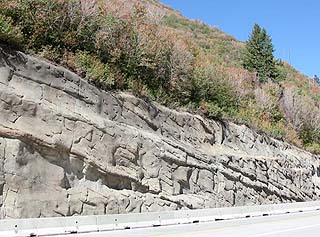|
Subscribe / Renew |
|
|
Contact Us |
|
| ► Subscribe to our Free Weekly Newsletter | |
| home | Welcome, sign in or click here to subscribe. | login |
Construction
| |
 |
May 2, 2003
Scenic canyon tests concrete’s beauty
DBM Contractors

Photo courtesy of DBM Contractors
This retaining wall in Utah was made to look like natural rock by using color, relief, shadowing and texture. |
Highway construction, which has traditionally focused on both safety and environmental protection, is now beginning to focus on aesthetics. This encourages construction partners to design and construct projects in a manner that uses and blends the finished product into its natural surroundings.
An example of the increased importance of aesthetics is Utah’s Provo Canyon project on Utah 189 from Vivian Park to the Wasatch county line. In 1995, construction began on a road widening and realignment project along the 1.5-mile stretch of the highway. A significant portion of the work included about 170,000 square feet of slope stabilization.
The slope stabilization system detailed for the project included a combination of soil nails and rock dowels covered by a temporary shotcrete facing (soil nail areas only) and a cast-in-place formed finish concrete facing covering all of the treated areas.
In 1997, the anchorage for the slope stabilization system was complete and construction began on the cast-in-place concrete facing. After constructing only 3,000 square feet (less than 5 percent of the treated area), residents of Provo Canyon voiced their concerns regarding its aesthetics and its stark contrast with the beauty of Provo Canyon.
Ultimately, the residents sought legal action against Utah’s Department of Transportation (UDOT) and were successful in getting the project stopped.
In 2001, UDOT issued a new technical proposal for the procurement of a design-build contractor to design and construct a new sculpted shotcrete facing to cover the existing slope stabilization system and the concrete facing previously installed.
Requirements for the new sculpted shotcrete facing included blending it into the natural canyon environment by incorporating color, texture, natural vegetation, relief, shadowing and pleasing transitions that matched or enhanced the surrounding physical features of the canyon — while also providing adequate structural capacity to work with the existing anchors in retaining the slopes.
Other important performance criteria for the sculpted shotcrete included durability to freeze-thaw conditions and providing a system that was waterproof to existing surficial runoff as well as existing ground water flows.
DBM Contractors assembled a team to design and construct the project that included CemRock Naturalistic Environments, a shotcrete subcontractor specializing in placement of sculpted shotcrete, and Golder Associates, a geotechnical engineering company specializing in the design of anchored earth retention systems.
One of the unique challenges that had to be addressed by the design-build team involved the subjective nature of the aesthetic requirements as defined by the contract specifications. The contract called for creating the Provo Canyon Aesthetics Team, which would be responsible for final acceptance of all aesthetic treatments associated with the project.
The Provo Canyon Aesthetics Team consisted of seven members: three local citizens from the Provo Canyon community, three UDOT employees with varying levels of project involvement and the UDOT project manager. The team met on site at various points during the course of the project to provide feedback to the design-build team regarding the aesthetic shotcrete treatments.
Site representatives from the design-build team attended the aesthetics team meetings, listened to comments and criticisms, answered questions, suggested possible solutions to concerns voiced by the team members and consolidated the collective aesthetics team feedback in order to establish goals for the remaining treatment areas.
This unique approach of establishing final acceptance criteria during the course of the work, rather than setting pre-defined acceptance standards, was successful on this fixed-price contract due to the ability of the design-build team to define, understand and manage the expectations of the aesthetics team.
The project contracts required a 75-year design life, and stipulated that the sculpted shotcrete be durable in freeze-thaw conditions as well as provide a waterproofing barrier to surficial runoff and ground water.
The sculpted shotcrete mix design proposed by the design-build team was formulated to address these technical requirements. One of the major aesthetic issues addressed by the mix design was the prevention of efflorescence, which can be described as the buildup of white stains caused by leached calcium salts from the shotcrete.
The admixture chosen lowered the production of calcium hydroxide during the hydration and curing process and also enhanced the waterproofing characteristics of the shotcrete. For freeze-thaw durability, air entrainment was added to the mix. Synthetic fiber reinforcement was also added to control shrinkage and temperature cracking.
Every simulated rock project has its own unique set of requirements and constraints. This particular one was larger than most artificial rockwork projects and had significant environmental concerns, plus heightened public scrutiny.
For the Provo Canyon project, our goal was to make the work as transparent as possible by producing a level of realism that maximized the aesthetic appeal of the finished product while minimizing its impact on the local ecology. This job significantly raises the bar on the quality of work that can be done on similar projects.
Construction was completed in October 2002 on schedule and under budget. At the conclusion of the project, a performance incentive fee was paid in full to DBM.
Jim Sexton, P.E., a DBM project manager, was in charge of the Utah DOT job. During his 13-year career, Sexton has worked on a variety of heavy-highway and civil construction projects, as well as specialty design-build geotechnical construction projects.
Other Stories:
- Nix the blisters for a smooth complexion
- Skate park shreds gnarly drug dealers
- Post-tension that concrete building?


